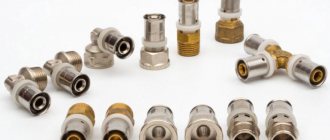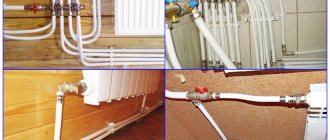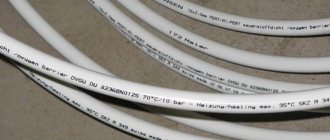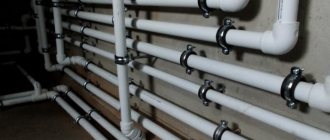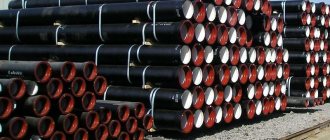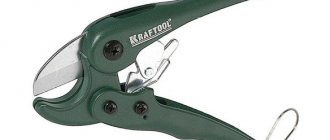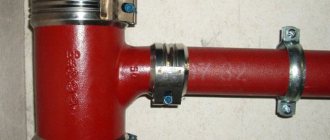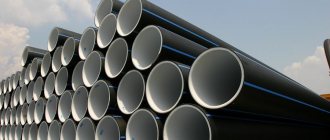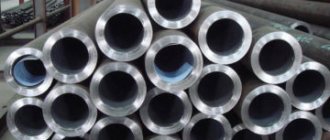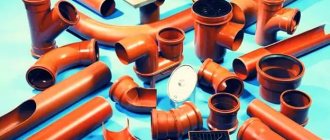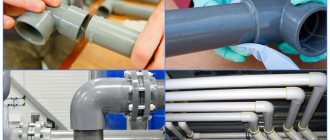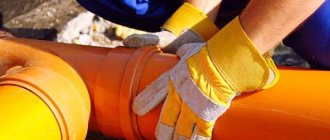Metal-plastic pipes are durable, flexible, have anti-corrosion properties and can withstand high temperatures and pressure. They are used in the organization of plumbing, heating, air conditioning systems, and are used in everyday life and in industrial enterprises. They are confidently ousting metal analogues from the market. In this article, we will consider in detail the characteristics and features of metal-plastic pipes, their scope of application, markings, advantages and possible disadvantages of use.
Design features of metal-plastic pipes
The design of metal-plastic pipes is multilayer, so the scope of application of the pipes is extensive. It consists of outer and inner layers of polyethylene and an aluminum layer located between them, secured with an adhesive adhesive layer.
The outer plastic layer serves as protection from the external environment. It has low thermal conductivity, therefore reducing the formation of condensation due to temperature changes. The inner layer of plastic is smooth and is not able to enter into a chemical reaction with the transported liquid. No deposits form on it, which facilitates the rapid and unhindered passage of water. The use of cross-linked polyethylene, which has a molecular memory effect, ensures that the original shape of the product is retained even after short-term deformation after loads.
Aluminum in the middle layer guarantees the necessary rigidity, the absence of thermal expansion when the water temperature rises, and is worthy of withstanding increased pressure. It also serves as a reliable barrier to oxygen, so there is absolutely no threat of aeration. The adhesive layer reliably holds the aluminum and polyethylene layers together, giving the product the necessary strength characteristics.
Installation of metal-plastic fittings
The word fitting literally means “to mount”, “to install”. Fittings are elements that are installed at the ends of pipeline sections. The most common fittings are coupling connectors, transitions to threaded connections, tees, elbows, expansion joints.
This manipulation is carried out using special pliers or a hydraulic press tool. This connection is durable, but completely eliminates disassembly in the future. If it is necessary to replace, for example, an elbow with a tee, it will be necessary to cut off an expensive disposable fitting and press a new one.
Pipe and fitting connection diagram
At the same time, in parallel with press fittings, a collapsible compression fitting is also used. This connection consists of several components: a bushing, a union nut, rubber O-rings and a retaining collet. A union nut and locking ring are placed on the end of the pipe, subsequent tightening securely fixes the pipe and fitting, and sealing is achieved. The advantages of this type of connection are:
- no special knowledge or skills are needed for independent installation;
- no expensive tools are required (only an adjustable wrench, plastic pipe scissors and a calibrator);
- the connection can be quickly disassembled at any time, achieving the “American” effect.
Flaws:
- Over time, especially with irregular heating use and poor installation, the fitting may become loose.
- Rubber O-rings will require replacement over time, this depends on the individual characteristics and operating conditions of the pipeline, however, once every 10 years it may be necessary to replace gaskets or tighten nuts.
Previously, adhesive fittings were also used, but due to the inconvenience of installation and low reliability, this type of connection quickly disappeared from the shelves of plumbing stores.
Metal-plastic products have proven themselves well in use for heating, water supply and irrigation. This is an inexpensive, but at the same time reliable solution that will allow you to do all the work yourself.
Active competition with PPR systems has shaken the position of metal-plastic, but there are still installation organizations and plumbers who prefer this type of pipeline installation.
Technical characteristics of metal-plastic pipes
The standard diameter of metal-plastic pipes is 16-63 millimeters. Also in this range are options 20, 26, 32, 40 mm.
In general, the technical characteristics of the products are as follows:
- The recommended temperature of the transported liquid is 95°C, maximum up to 110°C;
- Thermal expansion coefficient – 26 µm/m per 1°C;
- Working pressure – up to 1.013 MPa, maximum up to 1.52 MPa;
- Transverse tensile strength indicator – 2880 N;
- Thermal conductivity – 4.5 mW/cm2.
Metal-plastic pipes are sold in coils with lengths from 50 to 200 meters.
The thickness of the pipe walls and the aluminum gasket located inside depends on the diameter. For pipes with a diameter of 16 mm, the wall thickness is 2 mm, the thickness of the aluminum layer is 0.2 mm, for metal-plastic pipes with a diameter of 20 mm these values are 2.25 and 0.24 mm, respectively.
The weight of a linear meter is also directly dependent on the diameter:
- 16 mm – 115 grams;
- 20 mm – 170 grams.
What is metal-plastic
Metal-plastic pipes are composite products that consist of a combination of several layers of material. The most common structure of such a pipe includes an outer protective plastic layer, an adhesive base, an aluminum profile along the entire length of the pipe, a repeated adhesive layer, and an internal plastic coating. The main advantage of such a structure is expressed in the complete absence of the influence of corrosion or chemical aggressive materials on the supporting metal profile.
Main characteristics of a metal-plastic pipe:
- outer diameter of the pipe;
- type of plastic used. There are three types in total - PE-RT (heat-resistant polyethylene), PE-X (cross-linked polyethylene), PP-R (polypropylene);
- type of aluminum profile connection - can be overlapping or butt-to-butt;
- maximum temperature of the transported liquid - most manufacturers declare a maximum permissible operating temperature of 950°C;
- the maximum operating pressure is 25 bar, however, at elevated temperatures close to 1000°C, this figure can drop to 10 bar.
Marking of metal-plastic pipes
With the help of labeling, a knowledgeable buyer can immediately determine the main parameters of the product being offered to him - material, diameter, maximum permissible pressure. The notation is easy to understand. This information may be useful.
What markings are usually present on metal-plastic pipes:
- Indication of the manufacturing company and product name;
- Data on the certificate of conformity according to which the product was manufactured;
- Direct product characteristics.
The third block of information needs to be treated especially carefully, because it contains the main technical parameters.
Material:
- PP – polypropylene;
- PE – polyethylene;
- PEX – cross-linked polyethylene.
If cross-linked polyethylene is used as the material, then the method of cross-linking is indicated next to it:
- A – pyroxide;
- B – silane;
- C – flow of directed electrons;
- D – by the method of azo compound of molecules.
Other important data:
- The diameter of the metal-plastic pipe and the thickness of its walls are usually indicated in millimeters, but in some markings it may be in inches;
- Nominal pressure PN;
- Requirements for the transported liquid;
- Production date and batch number.
When installing metal-plastic pipes, it is recommended to position them so that the markings on the product are visible. This is necessary to accurately determine the type of pipes used in the event of force majeure situations or repairs.
Metal-plastic products owe their wide distribution to the unique combination of the positive qualities that plastic and metal possess. In order to make an intelligent choice of the appropriate type of pipe to solve a specific problem, you should dwell in more detail on the characteristics of metal-plastic products and remember their advantages once again.
Content
- Qualitative characteristics, disadvantages and advantages
- Pipe material and design
- How to choose the right one
- Area of use of video
- Technical information
- How to decipher the markings
- How to connect metal-plastic pipes video
Qualitative characteristics, disadvantages and advantages
Metal-plastic products owe their positive qualities to each material used in their manufacture; the advantages of pipes are:
- in resistance to corrosion processes,
- in resistance to overgrowing and siltation,
- environmental friendliness,
- throughput, almost 1.3 times higher than that of conventional metal pipes,
- resistance to active chemicals,
- strength, reliability, durability - their service life can be about 50 years,
- high ductility and low weight,
- low thermal conductivity,
- ease of assembly - installing metal-plastic pipes with your own hands is not at all difficult, and special equipment is not required for measuring - a pipe bender or welding machine,
- the ability to install the system inside walls,
- aesthetic appearance, painting of such products is not required.
Among the disadvantages of metal-plastic pipes, the following should be noted:
- Since the coefficients of linear expansion of plastic and metal are different, the result of frequent temperature changes can be the appearance of leaks at the joints; they usually arise as a result of weakening of these points.
- To prevent this situation, experts recommend laying pipes with a small margin, and installing compensation loops at bends.
- Bending of metal-plastic pipes is carried out using a spring, although by their nature the pipes are quite plastic, they can suffer from repeated configuration changes. Moreover, it is recommended to bend the pipe within certain radii.
- To bend pipes, you can use a special spring; to do the work yourself, insert a spring into the pipe and fill it with sand. In any case, the pitch of bends on the pipe should not exceed 50 cm. Metal-plastic products should not be twisted relative to their axis.
- In addition, metal-plastic pipes, the prices of which are approximately twice as high as, for example, polypropylene pipes, have lower strength characteristics. The fittings used during installation are also not cheap.
Pipe material and design
The design of a metal-plastic pipe consists of several layers. The internal one, which is in contact with the carrier, is made of polyethylene and is intended to impart strength. The second is aluminum foil; the structure of this material allows it to be used as a stabilizing agent that prevents the diffusion of oxygen. The layers are connected with special glue, and the edges of the foil are joined by laser welding. The finishing polyethylene layer has a beautiful white color.
This original structure of the pipes made it possible to significantly extend their service life.
Each of the layers of such a product performs specific tasks:
- cross-linked polyethylene inner layer - has an extremely smooth surface that prevents the deposition of salts and scale on the walls,
- both layers of polymer material help reduce thermal conductivity, reduce the likelihood of condensation forming on the surface,
- prevent the possibility of formation of galvanic couples: the aluminum pipe core with brass or steel pipeline elements.
Since the wall thickness is insignificant, for example, for pipes with a diameter of 16 mm it is only 2 mm, the weight of a linear meter of such a product is only 115 g.
How to choose the right one
In specialized building materials stores you can purchase metal-plastic pipes with a diameter of 16-63 mm. The most popular products are with a diameter of 16, 20, 26 mm. If the wiring in the house is quite extensive, then pipes with a diameter of 32 mm or 40 mm can be used.
To create a water supply system for an ordinary apartment, you can use a diameter of 16 mm or 20 mm. It is convenient to arrange them together - for the main wiring, use products of a larger diameter; for outlets (to faucets, a dishwasher or washing machine, a shower), a pipe with a smaller diameter is quite suitable. The benefit is that fittings for metal-plastic pipes with a diameter of 16 mm have a lower cost. If the pressure in the water supply system is normal, then pipes with a diameter of 16 mm can be used in it without any damage to the quality of the water supply.
Metal-plastic pipes are sold in coils; the length of the coil can range from 50 m to 200 m.
Area of use
Metal-plastic pipes are often used:
- for creating water supply systems in private houses and high-rise apartments,
- due to the absence of harmful impurities in the polyethylene coating of the pipes, they can be used to supply drinking water,
- They are used to construct gas pipelines and delivery systems for liquids of various kinds in all industries, in agricultural enterprises and transport.
- with their help, compressed air is successfully supplied,
- they are used to create air conditioning systems,
- They are used to construct shells for shielding and protecting electrical power cables.
There are also some restrictions on the use of metal-plastic pipes:
- They cannot be used to construct heating systems that will include elevator units,
- they cannot be used in rooms with a high fire hazard (class G),
- Such pipes cannot be used in systems with a working fluid pressure exceeding 10 bar,
- It is prohibited to install metal-plastic systems located close to heat sources whose surface temperature exceeds 150C.
Metal-plastic pipes are not used in the construction of fire-fighting water pipes, as well as overflow, signal or expansion pipes.
Technical information
One of the important quality indicators is their ability to withstand certain temperatures and pressures. For metal-plastic products, such indicators are quite high; at optimal operating temperatures ranging from 0 to +95C, the pressure in the pipeline can be about 10 bar.
With increasing pressure, temperature indicators should decrease, for example, with a pressure in the pipe of 25 bar, the temperature of the medium should not exceed +25C. The pipeline can withstand, without destruction, a short-term increase in the temperature of the carrier up to +110C. If the pipeline will operate at the maximum permissible temperatures, then the pressure in it should not exceed 10 bar. The maximum permissible pressure for a metal-plastic pipe at a temperature of +20C is 94 bar.
How to decipher the markings
Markings are applied to pipes in order to convey to the consumer the maximum useful information about these products and the optimal conditions for their operation. There may be some changes in the order of placement of information in the marking code, depending on the manufacturer, but in most cases it looks like this:
- First comes the name of the manufacturer.
- Next is information about the features of the product: material, method of stitching, protection from ultraviolet radiation, etc.
- The symbols PE-X, PE-R, PP-R indicate that the material for the manufacture of pipes was cross-linked polyethylene, polyethylene or polypropylene.
- Information on how the cross-linking was performed is indicated by symbols: a - pyroxide method, b - using silane, c - directed electrons, d - azo compound of molecules.
- The diameter of the products and the wall thickness of the pipes are indicated in mm; it is very rare to find an option when the diameter of metal-plastic pipes (from 20 to 1200 mm) is indicated in inches.
- Next, data on the nominal pressure (in bar) at a carrier temperature of +20C is entered into the code.
- Then it is indicated which medium can be transported using these pipes; for example, it is prohibited to transport chemically active substances in water pipes.
- The last digits in the marking indicate the production time of the pipes and the batch number.
Experts recommend that when assembling water supply or heating systems, it is possible to read the markings - if necessary, this will allow you to accurately determine which pipes were used during assembly.
How to connect metal-plastic pipes
Fittings are used as connecting elements when installing metal-plastic pipes. It is advisable to purchase them complete with pipes, i.e. The pipes themselves and the connecting elements for them must be from the same manufacturer, this will save time on assembly and reduce the complexity of installation work. The installation technology is quite simple; expensive equipment and tools are not required.
If compression fittings are used during installation work, then pressing will be done by tightening the union nut. If press fittings are used - by compressing the outer sleeve, using special pliers for metal-plastic pipes, you can buy them in construction supermarkets.
Press jaws can be used with a battery press or with an electric press unit. If small diameter pipes are used (from 14 mm to 20 mm), then manual pressing machines can be used. Compression fittings are connected using wrenches. It should be noted that it is impossible to disconnect the press connection; with a threaded connection, the nut can be unscrewed, but the insert will still remain connected to the pipe.
Author: Sergey and Svetlana Khudentsov
10
Advantages and disadvantages of metal-plastic pipes
If high-quality installation is carried out and recommendations for operation, temperature conditions and pressure are followed, the full service life of metal-plastic pipes will be at least 50 years. This is important, but not their only advantage.
Other positive qualities:
- Resistance to corrosion and the appearance of deposits on the internal walls;
- High degree of tightness;
- Increased throughput - thanks to smooth internal walls, it is at least 1.3 times better than metal analogues;
- Environmental safety, anti-toxicity;
- Resistance to aggressive environments;
- Light weight – simplifies transportation and facilitates installation even in difficult conditions;
- Plasticity and flexibility;
- Simple installation that you can do yourself;
- Possibility of creating pipelines of various configurations;
- The flexibility of metal-plastic pipes allows us to minimize the use of connecting elements;
- Minimum thermal conductivity, which is 175 times less than that of steel pipes and 1300 times less than that of copper pipes, which allows you to maintain the water temperature longer and reduce losses;
- Low noise level;
- No maintenance required;
- Ease of repair and replacement;
- External aesthetics.
Like any material, metal-plastic has disadvantages. How significant they are compared to the advantages is for the consumer to decide.
Traditionally, the disadvantages of metal-plastic pipes include:
- Low degree of resistance to mechanical stress, especially when used in open communications;
- Inability to withstand elevated temperatures and resist water hammer (not for all types of metal-plastic pipes);
- Static voltage accumulation;
- Gradual destruction during operation at low temperatures.
In general, any of these shortcomings will not be important if you pay careful attention to the location and operating conditions.
Structure and scope of use
A metal-plastic heating pipe has an inner layer of aluminum, on top of which glue and high-density polyethylene are applied using extrusion. Aluminum gives the product hydraulic and mechanical strength. It reduces the likelihood of damage to the line due to water hammer by more than 3 times and does not allow oxygen to pass through.
The inside is coated with a very thin layer of heat-resistant polyethylene, which provides an exceptionally smooth surface and resists corrosion. The material does not contain inclusions harmful to human health and can be used as a pipeline for supplying drinking water. The outer layer of polyethylene protects the line from mechanical damage. Good performance characteristics allow the use of metal-plastic in many areas:
- In internal water supply systems of buildings.
- In industry and agriculture for transporting liquid materials.
- For supplying compressed air.
- In air conditioning and ventilation systems.
- As a protective screen when installing low-current and power cable lines.
But most often metal-plastic pipes are used for plumbing and heating. According to experts, at least 20% of water supply lines, including hot water, are made of metal-plastic pipes.
Scope of application
Metal-plastic pipes manufactured in accordance with all quality standards are actively used in a variety of areas. In everyday life, they are actively used in hot and cold water supply and heating systems with various pressure levels.
You can also use them:
- Organize a heated floor, irrigation system, water supply to a swimming pool or water intake from a well or well;
- Repair a section of a metal pipeline that has become unusable;
- Lay communications for the operation of the air conditioning system.
In apartments, the most commonly used options are 16 and 20 mm in diameter. The latter are even more popular, since fittings for them are cheaper.
Metal-plastic pipes are no less actively used for work in the agricultural sector, industrial production, and transportation. The material does not come into contact with the environment, as well as transported substances, regardless of their temperature and composition, which allows these pipes to be used for pumping various liquids and compressed gases.
Installation and wiring - features
Three main wiring methods
Many people have heard the word “wiring”, but not everyone knows its meaning. The wiring includes the entire system and its accessories: plumbing fixtures, shut-off valves, faucets, water purification filters, water meters.
In order for each network to function efficiently, it is necessary to make the wiring and correctly connect all the pipeline elements.
Today, 3 wiring methods are used:
1. Consistent.
Used in apartments and private houses with a small number of risers and connection points. With this connection method, tees are connected to a single pipe. By installing the wiring in the bathtub in this way, you will get a compact structure with a small number of joints. Another advantage of the system is the speed and ease of installation.
Minus: when several taps are open, the pressure in the line drops.
Daisy chain wiring
2. Collector.
It is used in cases of connecting a large number of consumption points: washbasins, jacuzzi, bathtub, boiler, washing machine, toilets.
The main element is the collectors - devices thanks to which the pressure in the network is always stable. Then the water is transported to household or plumbing fixtures. They are installed separately on a branch with hot and cold water (indicated by numbers 4 and 5 in the diagram).
If the liquid supply to any device is cut off, then this does not affect other consumers and the structure operates as usual.
Collector type of wiring
3. Mixed.
This means that some devices are connected to the system using a collector, and some - in a series manner.
Mixed wiring
The wiring can be hidden, open, or combined.
Connection methods - advantages and disadvantages
The joining of mainline elements is carried out in three ways using fittings.
They are:
1. Collet.
The parts are suitable for joining risers made of different materials. Most often, this happens when part of an old network is replaced with a new one, or when metal products have to be joined to metal-plastic ones.
Advantages:
- reliability;
- possibility of reuse.
The main disadvantage is that the clamps loosen over time, which can cause leakage. It is not recommended to install collet parts in hard-to-reach places.
2. Compression
Many people prefer this docking method. When purchasing, you need to check for the presence of O-rings and a dielectric gasket. If one of the elements of the connecting structure is missing, the joint will not be airtight.
Pros:
- minimum number of tools: calibrator, nuts
- keys, pipe cutter;
- high quality;
- multiple use.
Minuses:
- assembly takes a long time;
- cannot be installed in hard-to-reach places (in wall grooves, under the floor);
- Regular leak testing is required.
3. Press fittings
Installation begins with removing the sleeve in order to check the quality of seals and gaskets. If the result is positive, you need to put a shank on the riser and check the placement of the edge of the product through the viewing window.
Important! A high-quality connection will be if the edge of the pipe fits snugly around the perimeter of the circle.
Therefore, you need to cut the end at an angle of 90⁰. Final clamping is carried out using special pliers. To do this, you need to spread the handles 180⁰, put the inserts of the required calibers, insert the riser into them and squeeze the handles until they stop.
Important! It is necessary to perform the operations accurately and correctly, since the procedure can be performed with one connector only 1 time.
Among the advantages should be highlighted:
- high reliability and long service life;
- Possibility of installation in hidden networks, in wall grooves, when installing heated floors.
Flaws:
- large financial costs for the purchase of special tools;
- impossibility of reuse.
Installation of a press connection on a metal-plastic pipe
Includes:
1. Housing shaped like a tee, coupling, or angle. Copper and brass are used to produce high-quality parts.
2. Sleeve . It is considered the basis of the connecting device. Stainless steel is used for production. When crimping a part, the pressing jaw pads are installed on the surface of the sleeve.
3. A clip made of an elastic substance in the shape of a ring. With its help, the sleeve is connected to the body. Thanks to the part, galvanic currents cannot spread throughout the entire system.
Preparatory work for installation is carried out in stages.
Stage 1 – cutting into pieces of the required length. Performed at right angles with a pipe cutter.
Stage 2 – cleaning the ends of the cut pieces. This is done with a sharp knife, after which you need to insert a calibrator inside, with which you can completely get rid of the resulting ovality at the end of the part.
Stage 3 – chamfering. This is done with a chamfer or a sharp knife.
After this, you need to place the fitting on the riser, observing the planting depth through a special window, take press pliers that are suitable for a given diameter, and press the handles all the way.
Important! You can check the quality of the connection like this: if the part is covered with two uniform annular strips, and the metal has the shape of an arc, then the crimping is done correctly.
Installation and connection technology (video)
Installation tools
The main requirement: the work must be done carefully, without using special forces, so as not to damage the structure. To do this, special tools should be used at each stage of highway construction.
At the first stage , you need to familiarize yourself with the drawn installation diagram of the future system. This is necessary to determine the exact number of connecting elements and the length of the required sections of metal-plastic pipes for further work with them. Use a tape measure and a marker (preferably black).
The second stage is cutting pieces of a specific length, cleaning the ends, calibrating and chamfering.
You can cut individual pieces with an ordinary hacksaw. But after this there will be a lot of burrs and notches, which will cause a loose connection. A hacksaw can deform the internal section. These flaws can be corrected with a knife and a chamfer. But all this can be avoided if you use special scissors.
A pipe cutter is best suited for cutting risers of small, medium and large diameters. This tool is used by professionals who regularly install metal structures. At the end of this stage, calibration is carried out.
The third stage is bending individual sections of the structure at the required angles. In the absence of a special tool, bending is performed using:
- steel spring;
- sand;
- construction hair dryer or blowtorch.
Many people prefer the first option, since unwanted deformation is eliminated during the bending process.
Important! If the length of a piece of pipe is significantly greater than the length of the spring, and the bend is made approximately in the middle of the riser, then a wire should be attached to the spring so that it can be retrieved after the procedure is completed.
You can perform the operation using sand, which is poured inside.
Important! When bending using sand, you need to close the end so that the bulk substance evenly fills the internal space and does not spill out.
Heating devices are used separately, or in combination with the two previous options. The procedure is performed as follows: after installing the spring or filling it with sand, warm up the necessary part of the riser, and then bend it with your own hands. The advantage of this method: the required area is heated evenly, which eliminates the possibility of collateral deformation.
Professional tool – pipe bender.
Advantages:
- bending occurs strictly at the required angle;
- can be used for all diameters;
- complete safety of the bending process.
The final stage is the connection of individual elements into a single water supply network. If the previous preparatory procedures have been carried out accurately and conscientiously, then to perform this operation you only need to have wrenches and (or) gas wrenches on hand.
What to look for when choosing
Now the construction market offers a huge selection of metal-plastic pipes from different manufacturers, differing in price and identical in appearance.
Follow a few simple tips to avoid having to make repeated repairs:
- Purchase products only in specialized stores and on websites that provide the necessary accompanying documentation and product certificates;
- Give preference to products from well-known manufacturers and do not strive for savings, which in the end will result in even greater expenses;
- Before purchasing, carefully read the labeling and make sure that it corresponds to the information that the seller provides about the product;
- Visually inspect the product, make sure that in the cut the pipe structure looks monolithic and there is no delamination visible on it.
The cheapest metal-plastic pipes on the market are labeled HDPE, PE-HD and PE-RS. They are not recommended for purchase, even if you want to save money, and the seller assures that there is no difference compared to more expensive products.
If you have doubts about your competence and the correctness of your choice, you should enlist the support of professionals. People with experience and knowledge will unmistakably distinguish a quality product from a cheap counterfeit and will help you select metal-plastic pipes with the necessary characteristics depending on the purpose of use.
Preparation and assembly of connections on fittings
First of all, we should mention calibration - a procedure that is sometimes neglected even by professionals. Meanwhile, metal-plastic pipes come from the factory in coils, and therefore, without calibration, they retain some ovality, which can then come out sideways. After all, when a fitting is inserted into a curved pipe, its O-rings simply tear out of the grooves, moving towards the fitting body.
All this leads to a decrease in the tightness of the connection, since the polyethylene sheath must be pressed directly against the fitting with rings. Moreover, polyethylene will inevitably soften when heated and be partially displaced from the area under the split ring. This means that if the O-rings are not in place, a leak may occur. The latter is usually easy to fix by tightening the nut, but sometimes not.
Installation of metal-plastic pipes
Let us add that with mandatory calibration, pipes with compression fittings can be laid openly. However, when such pipes are embedded in screeds or grooves, it is better to use press fittings.
If we talk about assembling heating systems, then, of course, there are few subtleties in this matter. When installing steel pipes, threaded connections are usually used, which are wound with plumbing flax. Such products are cut with a grinder or a hacksaw. The need for calibration and deburring and chamfering is not canceled. In addition, a jumper is required directly in front of the ball valves that shut off the radiator. Otherwise, the throttle or tap will regulate the flow of the entire riser.
When tightening the nut on a compression fitting, its body should be held with another wrench, otherwise you may accidentally break the tightness of previously made connections. Do not forget that turns of the heating line are made using special corner fittings, and not by bending the pipe. With a small radius, you may simply break the aluminum core, and too large a radius will look sloppy. When connecting the liner to the radiator, it is better to use special nuts - American ones. This connection allows you to quickly disconnect the heater if necessary.
Installation of MP products
When creating structures from MP, first of all, it is necessary to thoroughly develop a plan for the future system, which will describe the size of each part. This will allow the specialist to solder the MP structures as quickly as possible and thereby reduce the period of repair work.
After the calculations are carried out, parts of the required sizes are directly cut and fittings are selected. Depending on the selected fittings, further installation will occur:
- Installing MP pipes using compression fittings is a connection method in which the only necessary tools are a wrench and pruning shears. First, a crimp nut and a split-type ring are put on the MP product. Next, the fittings are placed all the way and secured to the fitting fitting. To secure the connection, the master will only need a wrench. Another important advantage of installing MP structures is that chamfering is not required. This method is mainly used for plumbing structures.
- Installation using clamp connections - for this installation, a specialist will need special press equipment. First of all, a clamping threaded sleeve is put on the end of the reinforcement and the required diameter of the product is adjusted using an expander. Next, the fitting is inserted into the resulting hole and pressed in using a hydraulic press. The main advantage of this installation method is the reliability of the structure; however, if leaks occur in the future, such a structure cannot be disconnected. This installation method is most often used for heating systems.
After the parts are formed, the surfaces are cleaned of burrs and irregularities for better adhesion during soldering. The installation of products intended for heating structures will not differ from the installation of products for water supply systems.
Decoding of production markings
The marking contains basic information about the characteristics and purpose of the pipeline. The sequence of values may differ from manufacturer to manufacturer. Standard designations:
- name of the manufacturing company;
- production standard, certificate number;
- type of materials used;
- nominal dimensions;
- maximum permissible pressure;
- environment suitable for transportation;
- additional operating conditions (temperature).
At the end, the batch number, shift number and production date are displayed.
